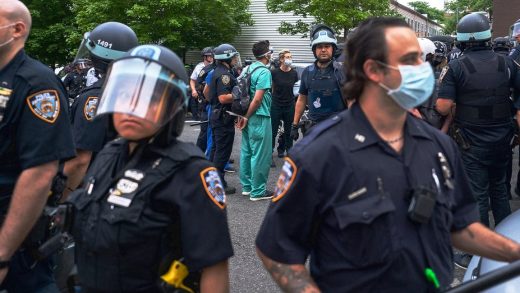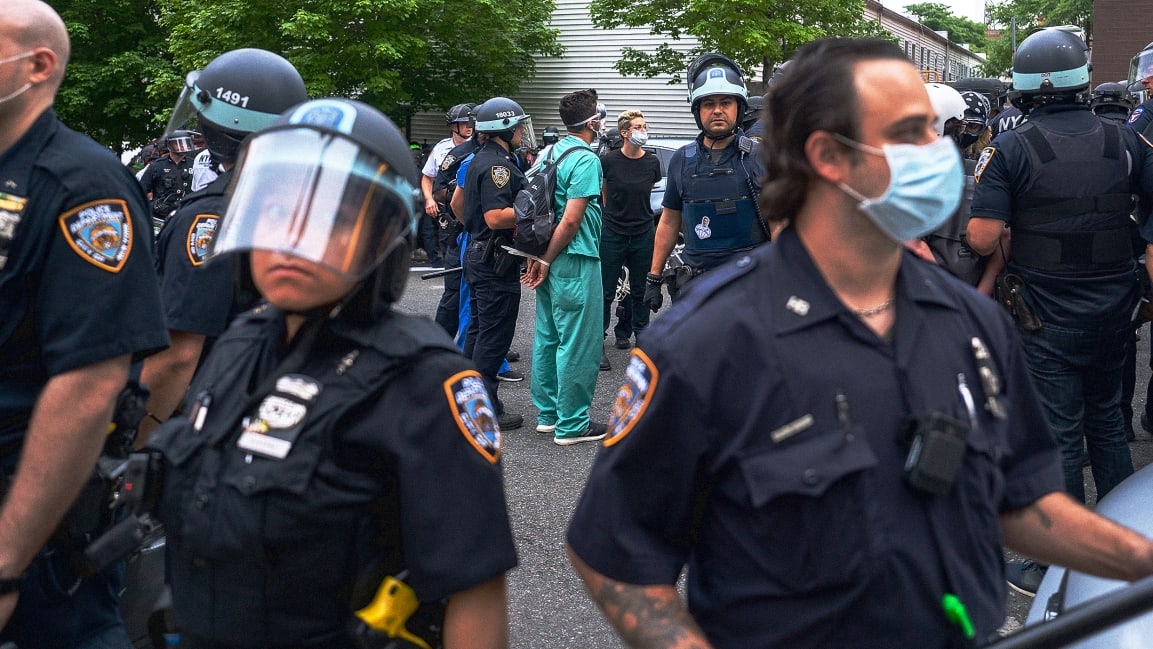Police conducted a ‘planned assault’ on protesters, according to a new visual investigation
When about 300 people gathered on the streets of the Bronx for a peaceful march one evening in early June, the New York Police Department was ready for them. According to a new report and video evidence collected from members of the public and analyzed by a team of human rights advocates and architects, officers deliberately trapped protesters using a tactic that resulted in violence and hundreds of arrests.
Like people in many other cities, the Bronx marchers had gathered to protest police violence in the days after the police killing of George Floyd in Minneapolis. An 8 p.m. curfew had been imposed in New York City in response to incidents of looting, and the protesters began their march around 7:20 p.m., with police following. Within a half hour, the police presence turned active and blocked the path of the march. After one blocked turn, the protesters headed down another street, only to meet a line of officers in front of the intersection. Four minutes before the curfew, another flank of police officers closed in from behind. The protesters were trapped. And then, as the two sides closed in, the batons began swinging, and more than 260 people were arrested.
These tactics are revealed in a new report from Human Rights Watch and an accompanying visual investigation from SITU Research, the research arm of the Brooklyn architecture studio SITU. Using 3D modeling and analysis of 155 videos collected from marchers and bystanders, SITU Research recreated the movement of the march, tracking its path through Bronx streets and showing how police blockades ended up moving the marchers down a street where they would soon be trapped, or “kettled.”
Shortly after 8 p.m., police began arresting protesters, and violence broke out. Protesters were pushed back and beaten with batons as police used tear gas and pepper spray. Based on the video evidence and interviews with marchers and observers, Human Rights Watch documented at least 61 instances of injuries sustained by protesters, legal observers from groups including the National Lawyers Guild and the New York Civil Liberties Union, and bystanders. One person suffered a broken nose. Another lost a tooth.
Human Rights Watch has condemned the police kettling tactic, calling it a “planned assault” and “a strategic effort to neutralize this public assembly” that “led to an unnecessarily violent and repressive result.” A known police tactic, kettling has been used by the NYPD in the past, including during protests at the 2004 Republican National Convention at Madison Square Garden. The report found that many of those arrested at the June march were held for hours without food or water, including some held overnight and one held up to a week. Many of those arrested were charged with Class B misdemeanors for curfew violations or unlawful assembly.
SITU Research’s visual recreation of the event suggests that the trap tactic was planned and executed without giving protesters the chance to disperse ahead of the curfew. This type of evidence-based analysis, known as forensic architecture, has been used by SITU Research and others to investigate and recreate events such as killings, bombings, and police misconduct. Combining visual evidence and the kind of digital modeling that architects typically use to design buildings, forensic architecture can provide a clear visual explanation of seemingly murky events, sometimes in contrast with official narratives.
As SITU Research’s video of the march shows, the people arrested for violating curfew were actually prevented by police from leaving the march. Combining camera phone footage from within the trapped crowd of protestors, people standing outside police barricades, and the windows of nearby buildings, the video offers clear evidence that the arrests were unwarranted.
The NYPD tells Fast Company that the report mischaracterizes the day’s events. “We take strong exception to the subjective characterization of our police actions to maintain public order as ‘a planned assault,’” said NYPD spokesperson Detective Sophia Mason in an emailed response.
Those arrested were given summonses or desk appearance tickets. In September, the Bronx district attorney filed a motion that dismissed the summonses, and the desk appearance tickets will also be dismissed. According to the report, about 100 protesters and observers intend to sue the city over the trap tactic and the subsequent violence and arrests. Human Rights Watch estimates that the lawsuits resulting from the NYPD’s trap could cost the city—and taxpayers—millions of dollars. With visual tools such as the ones used in the report, this kind of misconduct doesn’t have to go unpunished.
Fast Company , Read Full Story
(33)



